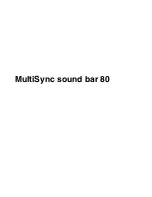
something with steady low frequencies (such as organ music) or continuous
test tones, not movie material. Move around the room and note where the
bass sounds best; if you place the subwoofer there and yourself in your chair,
you should get the same bass performance. Bear in mind that the test only
works if you have your ears as high off the floor as the subwoofer will be, so
don’t be afraid to crawl around. A recommended starting point for the
placement of this subwoofer would be in either of the front corners of the room
(on either side of the main speakers).
D. About Wall-Mounting for Surround and Other Uses
The VISO speaker’s rear baffle incorporates pilot holes which can easily
secure speakers to Vogel VLB50 brackets.
III. ADDITIONAL DETAILS ON CONFIGURING YOUR VISO SYSTEM
A. Important:
Always turn off your electronic equipment before connecting speakers.
If you don’t, severe damage to equipment and/or your ears may result.
B. Selecting Speaker Wire
We recommend the following gauge (thickness) of standard two-conductor
wire for the wiring distances specified;
if you prefer you can use thicker
(lower-gauge) wire
.
Under 25 ft (<7.5m)
18-gauge or 1.0 mm dia (lamp cord)
25 - 50 ft (7.5 - 15 m)
16-gauge or 1.3 mm dia (heater cord)
50 - 100 ft (15 - 30 m)
14-gauge or 1.6 mm dia
Over 100 ft (>30 m)
12-gauge or 2.0 mm dia
C. Configurations
Connect speakers identically to your amplifier or receiver on each
channel—
Red
amp/receiver terminal to
Red
speaker terminal,
Black
to
Black
. This will ensure that the diaphragms of the speakers of both channels
move forward and backward together (”in-phase”), rather that in opposition
(”out-of-phase”). In-phase connection provides maximum clarity and bass,
while out-of-phase connection results in frequency cancellations and
produces thinner and less distinct sound —with less bass, vague vocal
quality, and no solid center image. To help ensure the proper connection, the
two separate conducting wires in a standard two-conductor speaker cable are
coded in one way or another to be distinguishable from each other. (The
jacket of one wire may be ribbed or marked with “+” signs, or one wire under
the insulation may be a different colour from the other.) Use this wire-coding,
together with the amp/receiver and speaker colour-coding, to be sure you are
connecting the same wire of a given pair to a like-coded terminal at both ends
of your connection. (See figures 1 & 2)
D.
Tighten Terminals
Be sure all wiring terminals, are tightened firmly and securely, but be careful
7






































